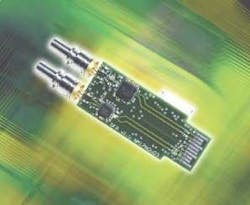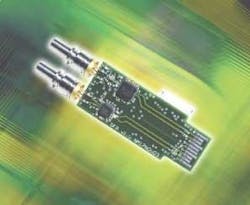Reference-design kits emerge for optical transceivers
Reference designs provided by IC vendors serve as a keystone of product development in the electronics world. Thus to many, it came as no surprise when IC vendors began to offer reference-design kits for optical transceivers and transceiver modules earlier this year.
In February, Analog Devices (Norwood, MA) released a reference design for a 2.5-Gbit/sec small-form-factor-pluggable (SFP) transceiver, the de facto multisource-agreement (MSA) form factor in the storage, Ethernet, and metro SONET/SDH markets. Market researcher iSuppli (El Segundo, CA) forecasts that seven million SFP transceivers will be used in the network storage market next year, and 1.4 billion OC-48 SFP transceivers in the telecommunications/metro SONET/SDH market during the same time period.
IC vendor Maxim also offers an SFP reference-design kit, and Vitesse Semiconductor (Camarillo, CA) has announced plans to introduce an SFP reference-design kit later this year. The IC vendors’ timing may be right on target, given that many OEMs are constrained by limited engineering and development resources.
Analog Devices’ SFP reference design includes a complete optical chipset (laser-diode driver, limiting amplifier, transimpedance amplifier [TIA], and analog microcontroller), supports SFF-8472 digital diagnostics, and targets a range of applications from 1- to 2-Gbit/sec SFP/SFF transceiver modules to OC-3 to OC-48 forward error correction SFP/SFF transceiver modules. The reference design provides board layouts, Gerber files, bill of materials, supervisor software, and an evaluation board. Customers can “copy” the reference design to quickly fill holes in an existing product line or use it as a blueprint to speed development of their own designs.“You can almost think of it like a microcontroller development kit,” explains Jim Doscher, marketing manager of high-speed networking at Analog Devices. “You can customize the modules, and you can add features that are beyond what is in the SFP spec. If you want to do a higher-functionality module like a DWDM module, you can add those functions to the existing microcontroller. And we find that some of the customers for these modules actually do have requirements beyond the specification.”
The idea behind the SFP reference-design kit was to accommodate Analog’s customers in the module business, companies with varying levels of expertise. “Some of our customers will probably never use this reference design and others may take it just as is and turn it into a manufacturable device,” says Doscher. ”If you have very talented customers, they will take your chips and they will set them up and they will get the good
performance out of them. But you don’t always get that. Even at 2.5-Gbit/sec speeds, it is still difficult to get this stuff to work correctly-and at 10 Gbits/sec, it is an enormous problem. Especially when you are doing the laser evaluations-the amount of time and energy and expense that’s required to make a laser work with a driver-it can be months of work to get that correct.”
“The IC vendors are contributing a lot towards the advancement of the SFP application,” says iSuppli senior industry analyst Jagdish Rebello. “There are increasing requirements for the IC vendors to do more and more so that module vendors can basically use lower-cost optics for more demanding applications. It is the optics that contribute to about 60-70% of the cost of the module.”
Lower module costs is one of the promises heralded by Vitesse, when it became the first IC vendor to unveil an IC reference design targeted at the 10-Gbit/sec XFP transceiver market in August (see Lightwave, September 2004, page 29). A highly anticipated market that had yet to emerge fully at the time of its XFP Pro announcement, Vitesse claims it was the only company to offer the complete chipset for an XFP: signal conditioner, TIA, and laser driver. The chipset, which is priced at $50 in volume, will allow XFP module manufacturers to price their transceivers in the $300-$500 range, according to Vitesse.
Nevertheless, it was somewhat surprising to Rebello that Vitesse chose to target the XFP, given the nascent market. He cites the example of Intel, which produced transceivers for 10-Gigabit Ethernet and 10-Gbit/sec Fibre Channel in hopes that they would be in a leadership position when the market recovered. However, demand for such devices has not materialized, in Rebello’s view, which has led Intel to the 4- and 2-Gbit/sec Fibre Channel SFP space. “The XFP 10-Gbit/sec market hasn’t developed to any extent that would attract a lot of vendors into the market,” he states. “I think Vitesse is trying to get the design wins in for the future and trying to get into the SFP as well.”
If IC vendors want design wins in the XFP module market, they should note that OEM evaluations are already underway. As such, Analog
Devices is working on an XFP reference design with expected availability next year. “XFP is going to happen,” says Doscher. “It has certainly been delayed more than people thought. You kind of have to get designed-in now to be there when the ramp happens.”
Optical-module manufacturers appear to welcome the reference-design kits. Picolight (Boulder, CO), a supplier of 2.5-Gbit/sec SFP transceivers, 10-Gbit/sec XFP transceivers, and transceiver components such as VCSELs, detectors, and subassemblies, applauds the move and views it as a business opportunity for its lasers and other components.
“This is absolutely the right move we think for us and we think it’s right for the industry,” exclaims Picolight chief executive Stan Swirhun. “It enables a new price level; a new cost level can be hit and therefore it really greases the skids for a sorely needed volume increase. There are all sorts of applications in communications ranging from voice over IP to video on demand that really could use 10-Gbit/sec short-reach fiber-optic modules and use them in very dense product configurations. In order for that to occur and for the services to be provided cost-effectively, then the fiber optics, which are a key element of the cost of those boxes, has to be provided cost-effectively. This pushes it exactly in the right direction.”
Finisar (Sunnyvale, CA), one of the founders of the XFP MSA, believes there is some value to reference-design kits as well. “I think it is helpful when those two or three chips have a common platform, especially if that would save us cost or facilitate time-to-market,” says Christian Urricariet, Finisar’s director of marketing, high-speed optics. “It doesn’t mean that it is the only option.”
However, established optical-module suppliers may face additional competition if reference designs invite new players into the market. “One could potentially see a lot of vendors from the Asian countries-China and Taiwan-who have developed some of the optical-component expertise, now entering into the optical-module space and competing against the JDSUs and Finisars,” notes Rebello. “The reference designs now greatly reduce the time-to-market for any product. So you do have this thing, which would essentially drive down cost and put further pricing pressures on the Finisars and JDSUs of the world, who are competing basically on quality and trying to sustain their long-term relationships.”
Picolight executive vice president Steve Hane believes that reference designs in the 10-Gbit/sec XFP market could give optical-component vendors such as Picolight new business. “When you look at the construction of a transceiver,” he explains, “there is the packaging, the ICs, and the optics source. The packaging is almost a level playing field; almost everyone can figure that out and the costs are relatively the same. What they’ve really done here is leveled out one of the critical variables, driving this opportunity back to the companies that own the optics components business. There will be new competitors that will take advantage of reference designs, but the last variable is the VCSELs themselves, and from a standpoint of having the manufacturing control, I think I will be very competitive, and at the same time I’ll be selling that VCSEL to some of these new players.”
To some, reference designs are the next step toward the commoditization of high-volume, MSA-based optical-transceiver modules, although most vendors would argue otherwise.
“Modules themselves pretty much are becoming commodities,” observes Lawrence Gasman, president and chief optical components analyst at Communications Industry Researchers (CIR-Charlottesville, VA). “OEMs are looking for a good price and a delivery schedule that suits them. They are not looking for any great innovation, so the module business in a sense begins to look like the connector business.”

